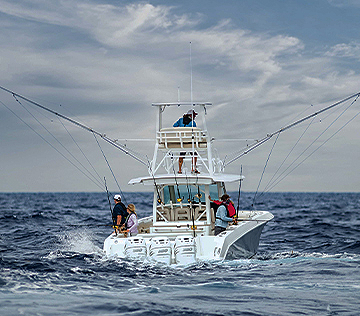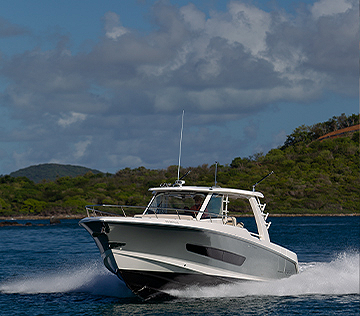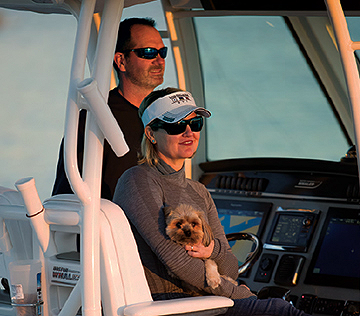
Top Offshore Fishing Tips
Successful offshore fishing is all about having the right equipment and technique.
What to Look For When Fishing Offshore
Heading offshore in search of fish can be intimidating; the ocean is so vast it’s hard to know where or what day and time to start your fishing trip. While fishfinders can help identify structure and drop-offs, which are known for attracting fish, pelagic species like mahi-mahi, wahoo and tuna move fast and aren’t as tied to underwater structure as snapper and grouper. Believe it or not, your eyes are the best tool for finding these fast-moving species. Look for anything different, like color changes, rip currents, and upwellings. Anything floating on the surface, from football field-size patches of yellow Sargassum weed to smaller objects like pieces of wood or even coconuts can attract small fish, which, in turn, attracts larger ones.
But by far, the best indicator of feeding fish is the presence of diving birds. Even one frigate bird hovering far above the water is a telltale sign since they will often follow pelagic species to be in a position to swoop down during feeding frenzies to eat bait being attacked by these predators. Try to anticipate the birds’ direction and position the boat in front of the path. Avoid roaring up to the frenzy while on plane because it will scare the fish off.
Birds far in the distance are hard to see, but technology can help spot targets that the naked eye can’t. Radar isn’t just for identifying bad weather or helping navigate in fog. Models like Boston Whaler’s 380 Outrage center console can be equipped with Simrad’s HALO series radar arrays that have a Bird+ mode that will help identify flocks out of eyesight. One plus is that birds that are wet from diving in the water will show a more vivid return, which further increases your chance of catching fish.
Vary the Speed and Depth When Trolling
Many saltwater anglers focus on presenting surface baits, and it makes sense. Baits like rigged ballyhoo happily skipping on the surface at 5-7 mph look like flying fish, and create commotion, which attracts predators. But if this technique isn’t catching fish, try other presentations like jigs and streamlined lures, which can be trolled faster. Wahoo, in particular, will attack baits trolled as fast as 20 mph. Try varying the boat’s speed. Slowing down and speeding up makes baits drop down and rise in the water column, which can trigger a strike.
Sometimes fish are down deep and won’t respond to surface baits and lures, so it’s always a good idea to have deep diving plugs like Mann’s Giganticus 50+ that can go 50-60 feet down and are proven fish catchers. Employing a downrigger, which uses a metal ball to drop a bait or lure to any depth you choose, is also a great way to fish the depths while moving. If you see a sonar return of a big fish, note the depth, drop down a lure or bait to match it and hold on.
Mahi-Mahi Madness
One of the easiest fish to catch offshore is the mahi-mahi, a.k.a. dolphinfish. A highly productive technique is to troll baits like ballyhoo beside Sargassum weed patches. When a fish is hooked, slow the boat down, reel in the other trolling baits, and work the hooked fish close to the boat. Usually, it will have company, and its schoolmates will stay in the vicinity as long as one fish stays hooked. When the hooked fish is near the boat, toss out live or cut bait to fire up the other fish. If the fish are small enough, break out light spinning rods and attach a piece of cut bait to an unweighted hook, toss it in the water and let it drift naturally next to the boat. When another fish is hooked, bring the first one in and put it in the fish box quickly; the big ones can flap around and whack someone. With small fish and light tackle, it’s an excellent opportunity for young kids who aren’t big enough to handle large offshore rods and reels. And if you can hook two or three simultaneously, the crazy frenzy that ensues will create a lasting memory.
Besides mahi-mahi, some other popular offshore or deep sea, big game fish species include:
- Amberjack
- Bluefin Tuna
- Cobia
- Kingfish or King Mackerel
- Red Snapper
- Sailfish
- Spanish Mackerel
- Wahoo
- White Marlin
- Yellowfin Tuna
The Latest Technology Helps Catch Fish
A modern fishfinder is the first step toward making technology work for you. Even smaller boats like Boston Whaler’s Montauk 150 can be factory-equipped with Simrad NSX fishfinder/GPS displays that employ CHIRP sonar transducers, which use multiple beams of sonar to separate the returns so individual fish can easily be spotted. This technology is also helpful for identifying fish on the bottom that can appear as structure on traditional sonar. Using an Active Imaging 3-in-1 transducer unlocks even more advanced technology like DownScan and SideScan, which give a near-photographic view of the bottom structure and location of fish.
Simrad uses C-Map, which employs next-gen Discover X cartography to display the most detailed and up-to-date bathymetry, giving users an extraordinarily detailed view of what’s on the bottom. Upgrade to Reveal X to get a 3-D view of the bottom and also receive the ability to add a satellite imagery overlay.
Tips for Rigging Your Offshore Fishing Boat
The most successful anglers have fishing boats that include a variety of enhancements, starting with lots of rod holders. Adding a hardtop gives the owner many options, such as adding even more rod holders and upgrading to include outriggers, which makes a medium-sized boat fish like a big one by spreading out multiple trolled lines to attract attention.
Many Boston Whaler models with multiple Mercury outboards like the 350 Realm express cruiser come equipped with Joystick Piloting for Outboards (JPO) system as a standard feature or option. While having joystick control is helpful for docking in challenging marinas, it also has many fishing uses. With it, drivers can keep the boat pointed at the fish so anglers hooked up to large fish can maintain the best angle. And instead of using a real anchor to hold a boat over fishy structure, drivers can select Sky Hook mode to use the engines to keep it in place. Another way to do this that keeps engine hours lower is to add a MotorGuide trolling motor, which has a feature similar to Sky Hook called Pinpoint GPS Anchor, that will keep the boat on station and allow drivers to stealthily approach feeding fish.
One of Boston Whalers’ many innovations is the addition of flip-down trolling seats on select models that allow those watching the spread to sit comfortably in the shade of the hard top while waiting for a bite. Boston Whaler is also known for its creative seating options that give anglers a comfortable seat.
Livewells are an essential component of a serious fishing boat, and the one on the Boston Whaler Outrage 280 checks all the boxes for what it should have: it’s part of the leaning post, so it’s on the centerline for better balance, it’s 30 gallons, is blue on the inside, has rounded corners, a clear lid, is pressurized and has a recirculating pump.
Offshore fishing is all about making lasting memories, and having the right equipment and knowledge will help catch fish, which is the part we remember most.



